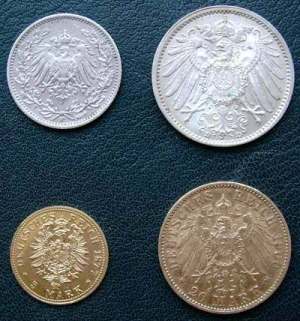German gold mark facts for kids
Quick facts for kids German Goldmark |
|||
|---|---|---|---|
| Mark (German) | |||
|
|||
| User(s) | |||
| Subunit | |||
| 1/100 | Pfennig | ||
| Symbol | ℳ | ||
| Pfennig | ₰ | ||
| Plural | Mark | ||
| Pfennig | Pfennig | ||
| Coins | 1, 2, 5, 10, 20, 25, 50 Pfennig 1, 2, 3, 5, 10, 20 Mark |
||
| Banknotes | 5, 10, 20, 50, 100, 1000 Mark | ||
| This infobox shows the latest status before this currency was rendered obsolete. | |||
The Goldmark (officially called just Mark) was the money used in the German Empire. This was the name for Germany between 1871 and 1918. The Goldmark was used from 1873 until 1914. Its special symbol was ℳ.
After 1914, Germany used a different type of money called the Papiermark. This new money was no longer connected to gold.
Contents
The Goldmark's Story: How Money Changed in Germany
Before Germany became one united country, different states had their own types of money. Most of these old currencies were based on silver. A popular silver coin was the Vereinsthaler. It contained about 16.67 grams of pure silver.
When Germany united, they decided to use a new money system based on gold. Even though the Goldmark was based on gold, they made it easy to switch from the old silver money. For example, 3 Goldmarks were equal to 1 Vereinsthaler.
From 1876, the Goldmark became the only official money in Germany. The name "Goldmark" was used later on. This was to tell it apart from the "Papiermark" (paper mark). The Papiermark lost a lot of its value after World War I because of something called hyperinflation.
The Goldmark was part of a "gold standard" system. This meant its value was directly linked to a certain amount of gold. For every kilogram of pure gold, there were 2790 Goldmarks. This made the Goldmark a very stable currency.
Germany's War Debts and the Goldmark
After World War I, Germany had to pay money to the countries that won the war. These payments were called World War I reparations. The winning countries wanted Germany to pay in Goldmarks. They were worried Germany might try to pay with the less valuable Papiermark.
Germany ended up paying about 20 billion Goldmarks between 1920 and 1931. Much of this money came from loans from banks in New York. Payments stopped in 1931.
After World War II, West Germany did not restart these payments. However, they did pay back the loans Germany had taken to make the original reparation payments. The last interest payment on these old debts was made on October 3, 2010. This was 20 years after Germany became united again.
Goldmark Coins: A Look at the Money
The German Empire made many different coins. Coins worth 1 Pfennig up to 1 Mark had the same design across the whole Empire. But coins worth more than 1 Mark were special. Each German state made its own designs for these coins.
The back of these coins usually showed the Reichsadler, which was the eagle symbol of the German Empire. The front often showed a picture of the ruler of that state, like a king or a duke. Free cities like Bremen, Hamburg, and Lübeck used their city's coat of arms instead.
Sometimes, special Commemorative coins were made for important events. These coins had unique designs. Many smaller states made very few coins. Also, during World War I, fewer coins were made overall. Well-kept examples of these rare coins can be quite valuable today.
Coins Made from Common Metals
- 1 Pfennig: Made of copper from 1873–1916, then aluminium from 1916–1918.
- 2 Pfennig: Made of copper from 1873–1916.
- 5 Pfennig: Made of cupro-nickel from 1873–1915, then iron from 1915–1922.
- 10 Pfennig: Made of cupro-nickel from 1873–1916, then iron and zinc from 1915–1922.
- 20 Pfennig: Made of cupro-nickel from 1887–1892.
- 25 Pfennig: Made of Nickel from 1909–1912.
Silver Coins
Silver coins were made of 90% pure silver. Each Mark in silver coins contained 5 grams of silver. They stopped making 2 and 5 Mark silver coins in 1915. The 1 Mark coins continued until 1916. Some 3 Mark coins were made until 1918, and ½ Mark coins until 1919.
- 20 Pfennig: (1 gram silver), made only until 1878.
- ½ Mark or 50 Pfennig: (2.5 grams silver).
- 1 Mark: (5 grams silver).
- 2 Mark: (10 grams silver).
- 3 Mark: (15 grams silver), started in 1908. This coin replaced the old Vereinsthaler coins.
- 5 Mark: (25 grams silver). This coin was similar in value to older large silver coins.
Gold Coins
Gold coins were also made of 90% pure gold. The standard was 2790 Marks for every kilogram of gold. They stopped making gold coins in 1915. The 5 Mark gold coins were only made in 1877 and 1878.
- 5 Mark: (1.7921 grams gold).
- 10 Mark: (3.5842 grams gold).
- 20 Mark: (7.1685 grams gold).
Images for kids
See also
 In Spanish: Marco de oro alemán para niños
In Spanish: Marco de oro alemán para niños






